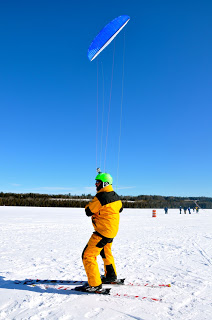I spent most of last week on Michigan’s Upper Peninsula where I had the opportunity to play in the cold and snow for a few days. As someone who grew up in that kind of climate, but now lives in a warm weather state, I always appreciate getting the chance to enjoy some winter activities. While there, I was able to ride a snowmobile through secluded backcountry and go snowshoeing on more than one occasion. But I also had the chance to spend a few days at the World Ice and Snow Sailing Association (WISSA) Championship, an experience I wrote about today at Gadling.com.
The event was a week-long affair that featured athletes from around the world coming to St. Ignace, Michigan to race on a small, frozen body of water called Chain Lake. Those athletes used a variety of wings, sails, and kites to propel them across the ice, sometimes at amazing speeds. Watching the top competitors harness the wind currents to generate momentum was nothing short of impressive and it was surprising how nimble and agile they were even at top speeds.
Of most interest to me were the kiters. Over the years, I’ve read and written my fair share of stories about how polar explorers have used kites to help propel them across some of the more remote places on our planet. While I always had a good understanding of how that worked, actually watching them in action was a great experience. I spoke to one of the competitors who told me that he routinely hit speeds in excess of 70 miles per hour on his home ice and has even set some unofficial speed records in the process. He let me hold on to his kite while it was in flight and the power that it generated was amazing. Steering the thing was no easy task either as it only required a few subtle movements of the wrist to adjust direction. For the inexperienced, like myself, it only took a few subtle movements to send the kite crashing into the ground as well.
While it was clear that the big kites were the best option for all-out speed, some of the other competitors preferred something that was a bit more agile on the ice. Those athletes gravitated towards the wings, which resemble a small paraglider, or a sailboard which look like the sailboards you would find on any beach save for the addition of skis attached to the bottom to help facilitate movement. Those different types of wind propulsion methods put the competitors into different race categories, but watching them all out on the ice was a bit like watching organized chaos at times. Each racer had his or her own individual approach to capturing the wind with some accelerating more quickly, while others were more capable at maneuvering across the slick surface.
As I mention in the Gadling article, one of the things that impressed me the most about the WISSA Championship is how close each of the competitors are with one another. In a way it felt like they were one big family who had gotten together for a little winter fun and the small, closely knit community reminded me of something that I’d see at an adventure race. Everyone was helping each other out, offering equipment to replace broken or damaged parts, sharing tips and insights on how to go faster, and generally having a good time. It was fun to be a part of that atmosphere even if it was just for a few days.
The WISSA Championship will go back to Finland next year, but the dedicated crew in Michigan that helped bring the event to North America for the first time hopes to continue hosting similar events in the future. The want to build a larger audience for the sport and attract a larger following moving forward. Hopefully they’ll be successful as it was a lot of fun to take part in.
To plan your own adventures in Michigan be sure to visit Michigan.org.
- Gear Review: The Xero Scrambler Mid is an Ultralight Hiking Shoe for Spring - March 1, 2023
- Gear Review: Yeti Roadie 48 Wheeled Cooler - August 18, 2022
- Kristin Harila Continues Pursuit of 8000-Meter Speed Record - August 16, 2022
